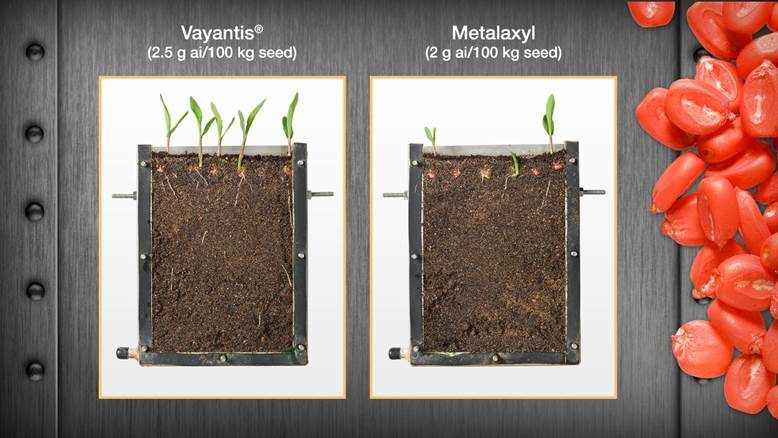GREENSBORO, N.C. – Syngenta announced that its newest corn seed treatment, Vayantis fungicide, has received registration by the U.S. Environmental Protection Agency (EPA). A completely new mode of action that represents one of the most intrinsically active compounds ever developed to protect corn from Pythium, Vayantis will be available in select areas for the 2021 growing season, with a full rollout for 2022 planting. Vayantis contains the active ingredient picarbutrazox, a completely new systemic fungicide seed treatment developed to protect seedlings from key blight and damping-off diseases, such as Pythium and Phytophthora, in many different crops with the first registrations occurring in corn and soybeans.
“Pythium is the No. 1 seedling disease threat for corn, causing more damage than Fusarium and Rhizoctonia seedling diseases combined,” said Dale Ireland, Ph.D., technical product lead for Syngenta Seedcare. “With Vayantis we are thrilled to give growers another tool to help them combat Pythium and protect their crops. By providing this unmatched disease protection, Vayantis helps increase potential yield by an average of 2 bushels per acre (bu/A) on the broad acre and 4 to 6 bu/A in moderate to high pressure situations, compared to other seed treatments.”
Pythium poses a great risk for U.S. corn growers. More than 50 known Pythium species commonly infest U.S. soil, resulting in damping off — the leading cause of yield loss in corn — as well as reduced plant stands, lower plant populations and reduced yield potential. Additionally, growing trends, such as planting earlier into cool wet soil and reduced and no-till situations as well as increased use of cover crops, increase the risk of Pythium presence and infection.
Protecting crops from Pythium is critical because once a seedling’s early growth and development are lost, they may never be regained, driving scientists and growers to increasingly call for more Pythium protection options.
“Low stands or poor development of crop plants is, unfortunately, a common occurrence for fields that were planted in many regions of Ohio with heavy soil or poorly drained soil,” said Anne Dorrance, Ph.D., Soybean Extension Plant Pathologist at The Ohio State University. “For management, improving soil drainage and having at least two active ingredients in the seed treatment mixture targeting water molds are necessary for the challenging areas in Ohio that have a history of replanting.”2
Additional Pythium activity options are also needed due to increasing resistance to current technologies. Documented cases of resistance and insensitivity of Pythium to the active ingredient ethaboxam indicate that current seed treatments are not adequate to fully protect against the threat. In lab testing, Vayantis demonstrated activity on all major Pythium species, including many isolates that show no sensitivity to ethaboxam. Containing more power per gram of active ingredient, Vayantis provides an overlapping mode of action, which enables a step-change for early-season Pythium protection.
With a lower use rate and much broader activity than other seed treatments, Vayantis enables more space on the seed and flexibility to add additional seed amendments without sacrificing best-in-class protection. Pythium is unpredictable since environmental conditions drive which species are troublesome in a given field any year, but growers can rest assured that there is no other Pythium active ingredient providing more protection than Vayantis.
The introduction of Vayantis represents one more tool to help growers combat disease with less inputs and offset variable environmental conditions associated with the existential threat of climate change. For over 40 years, Syngenta Seedcare has been on the forefront of seed treatment research and innovation, making deliberate, positive advancements in seed treatment technology for our customers. Through its Good Growth Plan, Syngenta continues to honor its commitments to secure the future of agriculture and our planet’s ecosystems.
To learn more about the performance expected from Vayantis, visit SyngentaUS.com/Vayantis or talk to a Syngenta sales representative. Join the conversation online — connect with Syngenta at Syngenta-us.com/social.
[1]Syngenta trials, 2015-2017, trial locations: MN, NE, IA, IL, WI, WI, IN, OH, KY
2Corn and Soybean Seedling Blights, published in C.O.R.N. Newsletter, 2020






